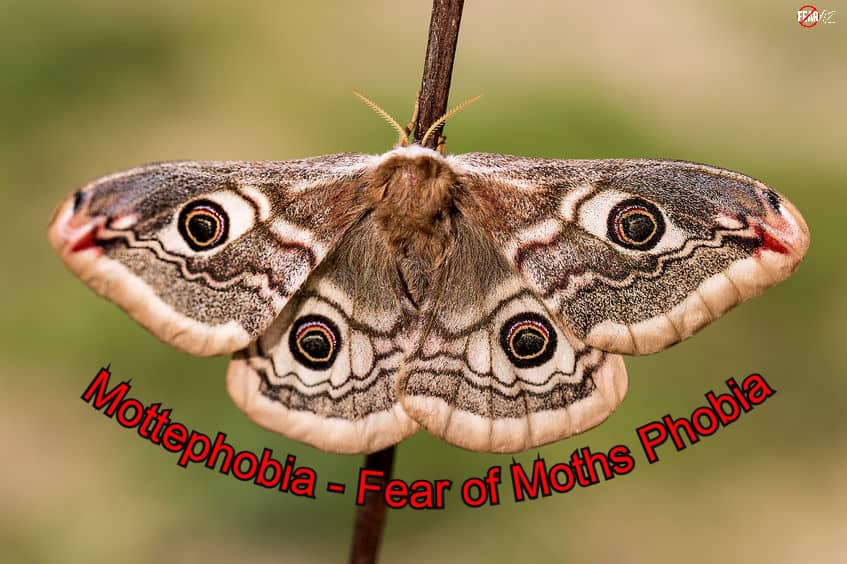Share This Article
Fear of Moths: Harmless Flying Insects or Your Nemesis?
Are you afraid of stepping out in the summer months when moths are everywhere? Do you avoid the porch light in summer because it attracts large moths?
Does your heart skip a beat when you hear the fluttering of moth wings? Do you ever picture in your head moths attacking you?
You can’t explain to insect lovers why you can’t stand these amazing, useful, and seemingly harmless creatures. And it’s difficult to tell others how your fear affects your enjoyment of the great outdoors.
If this all sounds too familiar, you may have a moth phobia. Mottephobia is defined as an irrational fear of moths. Basic things like checking your food or clothes for moths is normal behavior. Checking serval times, shaking clothes, banging shoes, staying clear of outdoor lights on a warm summer night, this may be seen as exaggerated anxiety, but for you, it’s no exaggeration.
It’s okay not to be a fan of moths because of their appearance. Some do look like alien creatures from comic books. However, screaming your head off or passing out when you see one is considered extreme. Before you can begin to get a handle on your moth phobia, you need to find its root cause. Education is the key, so lets dig in.

What You Need to Know about Mottephobia
The term mottephobia comes from the German word motte, which means “moth,” and the Greek word phobos, which means “fear.” A closely related excessive fear or phobia is lepidopterophobia or the fear of butterflies (and moths). However, many who are scared of moths have no problem with butterflies.
The fear of moths falls under specific animal anxiety phobias. It’s not as common as other animal phobias, such as arachnophobia, the fear of spiders. This, however, doesn’t mean it’s not widespread.
QUICK FACT:
Moths are known as accidental pollinators and are very useful insects in the natural world.
Fearing moths goes beyond disliking their dustlike appearance. It has more to do with intense and uncontrolled anxiety that can lead to panic attacks.
In some communities, moths hold particular spiritual meanings. To be specific, it’s widely believed someone will die if a moth appears in your home.
What Causes Fear of Moths
We may need to juggle your memory to understand where your fear of moths comes from. Can you remember a specific traumatic experience with a moth when you were young? Were you ever stuck in a room with moths at one point? Like many phobias, being scared of moths could stem from an unpleasant childhood experience.
QUICK FACT:
There are thought to be approximately 160,000 species of moth across the world.
Many of us are afraid of moths for their appearance. To the eye, a moth doesn’t appear as beautiful as a butterfly. Let’s face it—if a moth flies into your hair, which it often does because they’re highly unpredictable, you’ll probably consider it an unpleasant experience.
Another possible reason why you may be so scared of moths is lack of exposure. You may have grown up where moths were uncommon. You may have never visited the woodlands. If you saw moths for the first time while on a school field trip, it’s possible you reacted and maybe even got in trouble. This later developed into a bonafide fear.
Symptoms of Moth Phobia
On encountering moths, you may experience intense anxiety. The anxiety will grow into more anxious physical, mental, and emotional reactions. It may even become a panic attack in the worst case.
You’ll need to visit your mental health professional to determine if you indeed have a phobia of moths. However, if you’ve struggled with moth anxiety for at least six months, it’s a strong likelihood you do indeed have mottephobia.
Physical Symptoms
- Increased heartbeat
- Standing still in one spot because you are unable to move
- Shaking and trembling
- Running away from the scene
- Screaming
- Migraines
- Difficulty in breathing
Mental/Emotional Symptoms
- Extreme anxiety when exposed to moths
- Extreme nervousness just thinking about moths
- Heating up of the body due to fear
- Inability to control the anxiety in public
Mottephobia Treatment
Like other phobias, there’s no designated treatment for moth fear. Professionals administer therapy to treat the fear while medications are sometimes used to ease physical symptoms.
Self-Help Treatment for Fear of Moths
You can try and unlearn some of the acquired beliefs about moths. If you fear moths because of their spiritual meaning, for instance, tell yourself that’s a superstitious belief. You don’t have to pass out every time you spot a moth because you were made to believe that someone will die.
Work to train your mind to stop fearing moths. Replace negative thoughts with positive thoughts as a way to curb fear. The best way to address fear is to face it and not run away from it. Reprogramming your mind isn’t easy, as it requires practice. Tell yourself repeatedly that moths won’t hurt you.
Emotions are the driving engines of our lives, and they’re determined by what thoughts we allow into our minds. Think positive to be happy.
Professional Help
Therapy administered by professionals is the standard treatment for this fear. Exposure therapy has been found to be effective in treating the phobia of moths. A combination of therapies may help you get over your anxiety.
Augmented Reality Exposure Therapy (ARET)
Augmented reality exposure therapy or simply ARET involves exposure to moths. As a sufferer, it will be uncomfortable at first, but gradually, you’ll adjust. You’ll first be shown pictures and images of moths. After this, you’ll be introduced to real-life moths. You may move from watching them from a distance to actually holding them.
Cognitive Behavioral Therapy (CBT)
In CBT, a therapist will work with you to exchange your irrational fear of moths with more rational thoughts. An analysis is conducted on your thoughts, and then you’ll work with your therapist to find an alternate, more pleasant thought pattern.
Talk Therapy
As the name suggests, in talk therapy you can talk about your fears with a professional. From what you share in these sessions, your therapist will decide on the best approach to help you deal with your fears.
Your therapist will work to establish the severity of the fear and the possible ways in which it can be reduced. In the early stages, you’ll help your therapist understand your problem by presenting it in your own words. Be willing to cooperate so they may establish your school of thought and help you deal with your fear.
Talk therapy may also involve group therapy. In group therapy, you’ll share your fears with others who are going through similar challenges. It is always comforting to know you’re not going through something alone. In group, you’ll also be able to pick up tips from others on how to deal with your anxiety.
How to Cope with the Phobia of Moths
Coping with moth phobia isn’t easy. However, with the right therapy and desensitization you’ll learn to overcome your fear. It’s okay not to be comfortable while in a room full of moths, but it’s a cause for concern when a single moth may make you pass out.
Unfortunately, it may be common for those around you to laugh at your reaction to an insect. Don’t let this intimidate you. Do all it takes to learn to better manage your fear. While the fear may never go away completely, therapy will help you reduce your anxiety and symptoms, therefore reducing your reactions as well.
Conclusion
Moths may look frightening, but they are harmless. The statement “looks are deceiving” applies well to these creatures. Avoiding moths is an easy way out that works fine until you spot another one. In the long run, not treating your fear will affect your normal, daily life. The best approach to recovery is to seek professional help.



